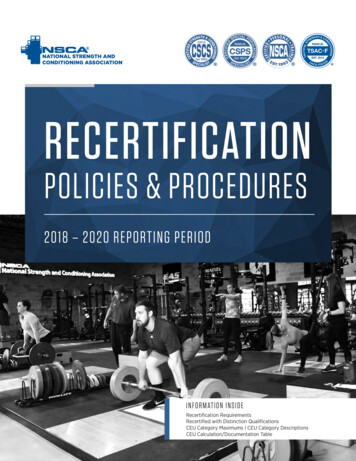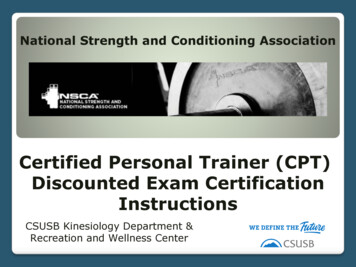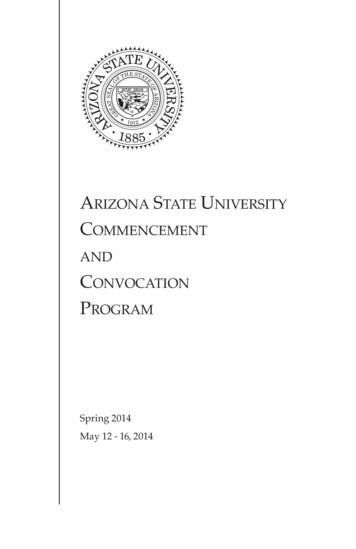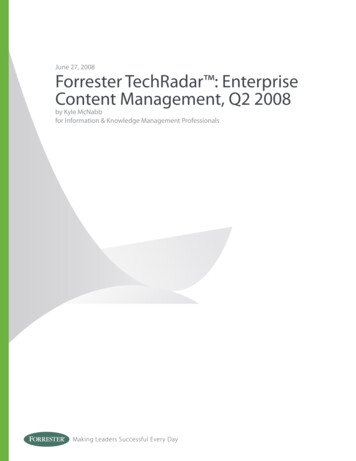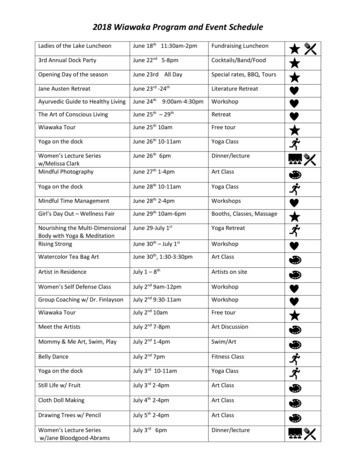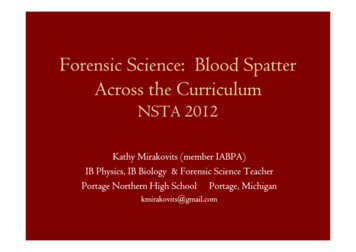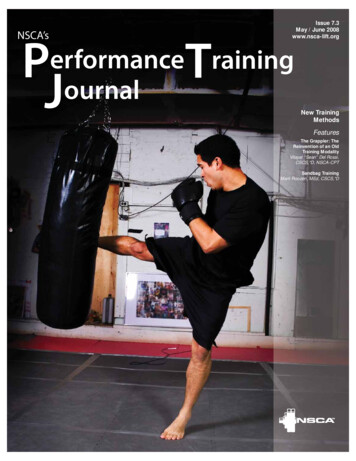
Transcription
Issue 7.3May / June iningNew TrainingMethodsFeaturesThe Grappler: TheReinvention of an OldTraining ModalityVilayat “Sean” Del Rossi,CSCS,*D, NSCA-CPTSandbag TrainingMark Roozen, MEd, CSCS,*D
about thisPUBLICATIONNSCA’s Performance Training Journal is a publicationof the National Strength andConditioningAssociation(NSCA). Articles can be accessed online at www.nsca-lift.org/perform.All material in this publication is copyrighted by NSCA.Permission is granted forfree redistribution of each issue or article in its entirety.Reprinted articles or articlesredistributed online should beaccompanied by the following credit line: “This articleoriginally appeared in NSCA’sPerformance Training Journal, apublication of the NationalStrength and ConditioningAssociation. For a free subscription to the journal, browseto www.nsca-lift.org/perform.”Permission to reprint or redistribute altered or excerptedmaterial will be granted on acase by case basis; all requestsmust be made in writing to theeditorial office.NSCA MissionAs the worldwide authority onstrength and conditioning, wesupport and disseminate research–based knowledge andits practical application, to improve athletic performance andfitness.Talk to us Share your questions and comments. We want to hear fromyou. Write to NSCA’s Performance Training Journal Editor, NSCA, 1885 Bob JohnsonDrive, Colorado Springs, CO80906, or send email to torial Office1885 Bob Johnson DriveColorado Springs, Colorado 80906Phone: 1 719-632-6722TrainingEditorial Review PanelScott Cheatham, DPT, OCS, ATC,CSCS, NSCA-CPTEditorJay Dawes, MS, CSCS,NSCA-CPT,*DKeith Cinea, MA, CSCS,*D,NSCA-CPT,*DMeredith Hale-Griffin, MS, CSCSSponsorship InformationRichard Irwinemail: rirwin@nsca-lift.orgMichael Hartman, MS, CSCS,*DMark S. Kovacs, MEd, CSCSBrian Newman, MS, CSCSMatthew Rhea, PhD, CSCSDavid Sandler, MS, CSCS,*DBrian K. Schilling, PhD, CSCSMark Stephenson, ATC, CSCS,*DDavid J. Szymanski, PhD, CSCS,*DChad D. Touchberry, MS, CSCSJoseph M. Warpeha, MA, CSCS,*D,NSCA-CPT,*DThe views stated in the NSCA’sPerformance Training Journalare those of the authors, anddo not necessarily reflect thepositions of the NSCA.nsca’s performance training journal www.nsca-lift.org volume 7 issue 32
CONTENTStable ofnew training methods10The Grappler:The Reinvention of anOld Training ModalityVilayat “Sean” Del Rossi, CSCS,*D,NSCA-CPTSandbag Training15 MarkRoozen, MEd, CSCS,*DLearn the benefits of sandbag training and how to incorporate it intoyour training program.This article examines how to performtraditional, and not so traditionalexercises on the grappler. Included isa sample program.departments4In The GymMuay Thai: Cross-Trainwith Thai Boxing For Funand Effective ResultsKyle Brown, CSCSUse this Muay Thai inspired workoutto invigorate your training.6Ounce of PreventionAssessing Athletic Balancewith the Star ExcursionBalance TestJason Brumitt, MSPT, SCS, ATC,CSCS,*DUse this cost effective test to see ifthere are any asymmetries in yourbalance. This article also discusseshow to use the star balance test inyour training.8Fitness FrontlinesTable17 TrainingPost-Exercise Nutrition:Recommendations forResistance and EnduranceTrainingDebra Wein, MS, RD, LDN, CSSD,NSCA-CPT,*D and GeorgianaMitrus, MSThis article discusses several studieson post-exercise (aerobic and anaerobic) nutrition, along with recommendations based on the research.Mind Games19 Triedand True Strategiesto Ensure Quality TrainingSuzie Tuffey Riewald, PhD,NSCA-CPTLearn reader submitted strategies toimprove your quality of training.G. Gregory Haff, PhD, CSCS,FNSCAThe latest news from the field on vibration training, body weight unloading, hypobaric hypoxia exposure, andsoccer match recovery.nsca’s performance training journal www.nsca-lift.org volume 7 issue 33
In the Gymabout theAUTHORKyle Brown is a healthand fitness expertwhose portfolio includeseverything from leadingworkshops for Fortune500 companies andKyle Brown, CSCSMuay Thai: Cross-Trainwith Thai Boxing For Funand Effective ResultsO365—Complete Nutritionalne of the hottest new fitness training methods is The foundation of the Thai-boxer’s conditioning is the useMMA (Mixed Martial Arts) training. Its benefits are of Thai-pads. Thai-pads are heavy pads strapped to thenot just for competitors or self defense, but also for cross- arms of a trainer/workout partner that work as targets totraining conditioning. A wide variety of men and women absorb the impact of the strikes and allow the athlete to refrom serious athletes to desk jockeys and housewives are act to the attacks of the pad holder. This method of trainingembracing MMA training to enhance their fitness level. is advantageous to the heavy bag in that it allows the fighterConsidered to be the most brutal of the Martial Arts, Muay to respond to a “live” opponent (3). Lastly, the heavy bagThai (Thai-boxing) includes kicking and punching as well training can be used in addition to the Thai-pads and focusas devastating elbow, knee, and shin strikes (1). Muay Thai mitts for conditioning and power training. However, if youis one of the best sports for physical conditioning and a do not have the benefit of a trainer/workout partner, a Thaigreat compliment to your resistance training program for heavy bag or Body Opponent Bag (BOB) can be utilized.fun and effective results.A typical Muay Thai training program includes three tofive minute rounds alternating between these various training skills – followed by a minute or two-minute rest periodBenefitsAthletes and weekend warriors alike can benefit from in- (3). If you are looking to include Muay Thai into your fitcorporating Muay Thai conditioning into their workout ness routine but do not have the time to make it a separateroutine without the dangers of combat. Muay Thai train- workout from your resistance training days, you can ining methods develop incredible speed, agility, cardiovascu- corporate it into your resistance training workouts. Tablelar endurance, flexibility, strength, and power. Side benefits 1 provides a sample 45 to 60 minute Resistance Training/include: stress relief, increased confidence, self defense Muay Thai Workout. Shake (www.fit365.com).skills, and exciting, challenging workouts (2).publishing nutritionarticles in top rankedfitness journals, to trainingcelebrity clientele—frompro athletes to CEOsto multiplatinumrecording artists. Kyle’sunique approach tohealth and fitnessemphasizes nutrition andsupplementation as thefoundation for optimalwellness. After playingwater polo for IndianaUniversity, as well as inLondon, Kyle becameinvolved in bodybuildingand fitness for sportspecific training. Kyleis the creator and ChiefOperating Officer for FITConditioningNearly all techniques in Muay Thai involve movement ofthe entire body. The foundation of these movements involves rotating the hips with each kick, punch, and block.The power behind each striking movement comes from thecore—not the lever being used (the arms or legs). This intense focus on the core is a big part of what differentiatesMuay Thai from other Martial Arts (2).References1. Kraitus, P, Kraitus, P. Muay Thai: The Most DistinguishedArt of Fighting: 9th edition. Phuket, Thailand: Asia Books,2006.2. Mousel T. The Thai Boxing Workout: A ScientificApproach. Accessed May 22, 2008 from http://e z i n e a r t i c l e s . c o m / ? T h e - T h a i b o x i n g - Wo r k o u t : - A Scientific-Approach&id 200986, 2006.3. Rebac Z. (1987) Thai Boxing Dynamite: The ExplosiveArt of Muay Thai. Boulder, CO: Paladin Press, 1987.Muay Thai-specific training includes using Thai-pads, focus mitts, heavy bag, and sparring. Muay Thai athletes alsouse traditional combat sport conditioning methods likerunning, shadowboxing, jumping rope, weight training,bodyweight-resistance exercises, medicine-ball exercises,and abdominal exercises (1).nsca’s performance training journal www.nsca-lift.org volume 7 issue 34
In the GymMuay Thai: Cross-Train With Thai BoxingPart 1. Dynamic Warm UpTable 1Complete all 3 movements back to back then repeatExercisesSetsReps/TimeRestNotesJump Rope13 minutesmoderate intensity30 secondsWalking Lungesw/ twist215 steps each leg15 to 30 secondsSupersetSpeedJumping Jacks230 seconds15 to 30 secondsSupersetSample ResistanceTraining / MuayThai WorkoutPart 2. Resistance TrainingComplete all 3 movements back to back then repeatExercisesSetsReps/TimeRestNotesDumbbellChest Press212 – 15 reps15 – 30 secondsSupersetLeg Press212 – 15 reps15 – 30 secondsSupersetSeated Lat Rows212 – 15 reps15 – 30 secondsSupersetPart 3. Muay Thai TrainingExercisesSetsReps/TimeRestNotesShadow Boxing21 minute slowstep by stepcombinationsfollowed by 3minutes highintensity30 secondsFocus onmechanicsFocus Mitts23 minutes highintensity1 minutePunches, crosspunches,UppercutsThai Pad Strikes23 minutes highintensity1 minuteIntertwine kicks,knees, and shinsHeavy Bag(BOB) Strikes23 minutes highintensity1 minuteIntertwine kicks,punches, knees,and shinsJump Rope13 minutes highintensity1 minutensca’s performance training journal www.nsca-lift.org volume 7 issue 35
Ounce ofPreventionabout theAUTHORJason Brumitt is aninstructor of physicaltherapy at PacificUniversity in Hillsboro,Oregon. He is a boardcertified sports physicaltherapy, an athletic trainer,and a certified strengthand conditioning specialistwith distinction. He maybe reached by email atjbrumitt72@hotmail.com.Jason Brumitt, MSPT, SCS, ATC, CSCS,*DAssessing Athletic Balance withthe Star Excursion Balance TestCoaches and sports medicine professionals generally agree that athletes should possess good balance in order to be successful at their sport. The termbalance relates to one’s ability to maintain his or hercenter of mass within his or her base of support. Forexample, a running back demonstrates good dynamicbalance by staying upright and continuing forwardprogress despite being hit by a defensive back.Balance training is often incorporated into a functionalexercise program. Coaches and sports medicine professionals are usually able to observe and correct gross balance dysfunction with specific exercises or drills. However, subtle side-to-side movement asymmetries mayexist and ultimately go unnoticed. An athlete with anasymmetry may have an increased risk of experiencingan injury (2).The Star ExcursionBalance TestState-of-the-art computerized balance machines canbe used to identify asymmetries in athletic individuals.However, most high schools and colleges are unable toafford the high price tag associated with these machines.There is a low tech, inexpensive option called the StarExcursion Balance Test (SEBT) which can be utilizedby coaches and sports medicine professionals to quicklyassess an athlete’s dynamic balance (1, 2).The SEBT is proving to be an effective tool in predicting injury risk. Researchers from Rocky Mountain University of Health Professions (Provo, Utah) found thathigh school basketball players with asymmetrical reachdistances (as little as 4 centimeters) had a greater risk ofexperiencing a lower extremity injury (2).Constructing andPerforming the SEBTThe “star” is easy to construct and requires minimalspace (figure 1). First, cut athletic tape into four 6 to8-foot strips (1). Lay two strips on the floor in the lPosteromedialPosterolateralPosteriorFigure 1. Star Excursion Balance Testof a “ ”. Place the remaining two strips on the floor intersecting the “ ” at 45 angles (forming an “x”).To initiate testing, stand on one leg at the center ofthe “star” (figure 2). Reach with the opposite leg in aparticular direction as far as possible, touching the tapewith either the forefoot or toes (figure 3 & 4). A testershould then mark this point for future measurement(1). Return to the starting position after each reachingtrial. Repeat a test if unable to maintain balance on thestance leg during the reaching motion or if the reachingleg is used to provide support during the test (1). Testsshould be performed in all eight motions to allow forside-to-side comparisons.Balance andMovement TrainingThe “star” can also be effectively incorporated into atraining or rehabilitation program. If an asymmetry ispresented, reaching or movement patterns may be performed in the challenging direction. Figure 5 demonstrates how to perform a functional movement patternto address a posterior movement dysfunction.nsca’s performance training journal www.nsca-lift.org volume 7 issue 36
Ounce of PreventionAssessing Athletic Balance with the StarExcursion Balance TestConclusionThe SEBT is gaining popularity for both its ease ofuse in clinical settings and its reliability in research.The potential uses of the SEBT are only limited bythe coach’s or clinician’s imagination. References1. Hertel, J, Miller, SJ, Denegar, CR. Intratester andintertester reliability during the star excursionbalance tests. J Sport Rehab 9:104 – 116, 2000.2. Plisky, PJ, Rauh, MJ, Kaminski, TW, Underwood,FB. Star excursion balance test as a predictor oflower extremity injury in high school basketballplayers. J Orthop Sports Phys Ther. 36(12):911 – 919, 2006.Figure 2. SEBT Starting PositionFigure 3. Reaching with the right legin the anterolateral direction.Figure 4. Reaching with the right legin the posteromedial direction.Figure 5. Posterior lunge with ipsilateral trunk rotation.nsca’s performance training journal www.nsca-lift.org volume 7 issue 37
FitnessFrontlinesabout theAUTHORG. Gregory Haff is anassistant professor inthe Division of ExercisePhysiology at the MedicalSchool at West VirginiaUniversity in Morgantown,WV. He is a member ofthe National Strength andConditioning Association’sBoard of Directors. He isa Fellow of the NationalStrength and ConditioningAssociation. Dr. Haffreceived the NationalStrength and ConditioningAssociation’s YoungInvestigator Awardin 2001.G. Gregory Haff, PhD, CSCS, FNSCACombining Stretching withVibration Increases Flexibilitybut Does not CompromiseExplosive StrengthSpeed Training with BodyWeight Unloading ImprovesEnergy Cost and Maximal Speedin Healthy Older WomenTraditionally, the inclusion of passive stretching in a When looking at independence in older adults it seemswarm-up session has been demonstrated to result in that walking speed is very important. In order to effecreductions in maximal strength, rate of force develop- tively improve walking performance many exercise inment, power generating capacity, and explosive perfor- terventions have been employed with varying degrees ofmance. For some athletes, such as gymnasts, this may success. Several studies have suggested that body weightcreate a problem as pre-event stretching assists them in unloading in conjunction with treadmill work can reachieving specific positions. On method of improving habilitate individuals with various neurological andflexibility that has recently received some attention is orthopedic impairments which result in some form ofa combination of passive stretching and vibration. Re- locomotor impairment. The process of unloading bodysearchers from East Tennessee State University’s Sports weight appears to allow the individual to walk at a fasterPerformance Consortium recently examined the effects speed. Therefore it was hypothesized that a progressiveof combining stretching and vibration on markers of ex- training program which employed over-speed trainingplosive strength with 22 female gymnasts (age 11.3 2.6 on a treadmill and body weight unloading would reyr; body mass 35.3 11.6 kg). Subjects performed sev- sult in a significant increase in maximal walking speed.eral treatments: 1) vibration stretching, 2) vibration Eleven older women (age: 79.6 3.7) participated inonly, and 3) stretching only. The vibration treatment 12 weeks of training which consisted of three days perconsisted of three sets of four sets of vibration at 10 s week of training. During the first six weeks the subjectsvibration bouts of 30 Hz vibration interspersed with performed with 40% body weight unloading at a speedfive seconds of recovery on four lower body sites. The that corresponded to the highest walking speed the subnon-stretching treatments consisted of quiet rest for jects could tolerate, or a rating of perceived exertion ofthe duration used for the vibration treatment. The re- 15. Each session consisted of four sets of five minutesults of the study confirmed that the inclusion of 30 walking which contained three, one minute high speedHz of vibration during a stretching protocol resulted in intervals and two, one minute intervals performed atsignificantly greater increases in markers of flexibility a comfortable walking speed. Across the six weeks thewhen compared to stretching alone or vibration alone. speed of movement was progressively increased. DuringAdditionally, the inclusion of vibration performed in the second half of the study (last six weeks) the amountconjunction with stretching resulted in no strength of body weight unloading was reduced to 10%. Afterpower performance decrements as indicated by a main- the completion of the study the treatment group demtenance of vertical jump displacement. Conversely, the onstrated a 18 – 21% decrease in the energy cost ofstretching only group demonstrated significant decreas- walking, a 13% increase in maximal walking speed, andes in jumping performance. Therefore these data seem a 67% increase in the speed at which they could walkto suggest that if stretching must be done prior to a comfortably. Ultimately this type of protocol appearstechnical skill that requires range of motion and explo- to be very effective at improving walking economy andsive power production it should be done in conjunction performance with this population. Therefore, this typewith a 30 hz vibration. Currently this line of research is of novel training may be very useful when working within its infancy but looks promising as a tool to enhance clinical populations.the athlete’s performance by optimizing the effectiveThomas, EE, De Vito, G, Macaluso, A. Speed trainingness of the warm-up period.Kinser, AM, Ramsey, MW, O’Bryant, HS, Ayres, CA,Sands, WA, Stone MH. Vibration and stretching effectson flexibility and explosive strength in young gymnasts.Med Sci Sports Exerc 40:133 – 140. 2008.with body weight unloading improves walking energycost and maximal speed in 75- to 85-year-old healthywomen. J Appl Physiol 103:1598 – 1603. 2007.nsca’s performance training journal www.nsca-lift.org volume 7 issue 38
Fitness FrontlinesFour Weeks of IntermittentHypobaric HypoxiaExposure Coupled withSea Level Training DoesNot Improve Sub-maximalExercise Economy inWell-Trained Swimmersand Runnerstreatment groups for exercise economy, heartrate response, ventilation or velocity at maximalaerobic power. The results of this study suggested that intermittent hypobaric hypoxia exposurecoupled with sea level training did not result inany improvement in exercise economy.Truijens, MJ, Rodriguez, FA, Townsend, NE, StrayGundersen, J, Gore, CJ, Levine, BD. The effectof intermittent hypobaric hypoxic exposureand sea level training on submaximal economyRecently it has been suggested that short periodsin well-trained swimmers and runners. J Applof hpyobaric hypoxic exposure may serve as aPhysiol 104:328 – 337. 2008.time-efficient variant of the “live high-train low”altitude training paradigm. Ideally the conceptcenters on the fact that altitude acclimatization What should a Soccerstimulates positive physiological adaptations Player do to Recovery insuch as accelerated red blood cell production has Between Two Successivebeen suggested to improve submaximal exercise Matches?economy. It was determined that limited data Women’s soccer has increased in popularity andexists in the scientific literature about intermit- the number of matches in a year has increased intent altitude exposure which is interspersed with crementally, as has the distance covered during asea level normoxia. Therefore the purpose of this match. With this increase in number of matchesstudy was to explore the effects of intermittent it is not uncommon to see multiple competihypobaric hypoxic exposure coupled with sea tions in close proximity to one another. Whenlevel training on submaximal exercise economy. this occurs it is essential that the athlete is ableTwenty three well trained athletes (10 runners to recover from the accumulated neuromuscularand 13 swimmers) participated in this four week fatigue and subsequent biochemical changes bestudy. The group was randomly assigned to one tween clustered groups of multiple matches. Inof two groups: group 1 was assigned to the hy- order to determine the optimal recovery strategypobaric hypoxia treatment (simulated altitude of researchers from Sweden and Norway examined4,000 – 5,500 m), and group 2 was assigned to the effect of passive and active recovery intervena normoxia treatment (simulated 500 m). Both tions employed between two successive soccergroups rested in the hypobaric chamber for three matches. Seventeen elite women soccer playershours per day five days per week for four weeks were randomly assigned to either a passive (n 9)and performed their regular training program. or active (n 8) recovery protocol. Subjects thenPerformance testing was conducted before and played two matches in a four day period withafter the four week intervention. When examin- only two days between each match. The activeing the data there was no difference between the recovery group performed a low intensity aero-bic (60% Heart Rate Peak) and resistance training ( 50% 1-RM) 22 and 46 hours after the firstmatch. Perceived muscle soreness, sprint, jumping, and isokinetic performance were performedprior to, immediately after match one, five hoursafter match one, recovery session one, recoverysession two, and soccer match two. Additionally,blood measures of creatine kinase, blood ureaand uric acid were measured before and aftereach soccer match and prior to each recoverytraining session. Sprint performance was foundto recover by five hours after match one, whileisokinetic knee flexion force generating capacitydid not return to baseline until 27 hours postmatch one. Muscle soreness was not returned tobaseline until 69 hours after match one. Finally,jumping performance did not return to baselineduring any point of the study. When examiningthe treatment effects it was determined that thetype of recovery session employed did not impact the rate of recovery. Ultimately it appearsthat recovery for neuromuscular and biochemical parameters exhibit very different recoverypatterns. While an active recovery protocol didnot result in significant alterations in these patterns, specific protocols to aid in recovery stillneed to be explored to optimize the post training and competition recovery patterns. Andersson, H, Raastad, T, Nilsson, J, Paulsen, G,Garthe, I, Kadi, F. Neuromuscular fatigue andrecovery in elite female soccer: effects of activerecovery. Med Sci Sports Exerc 40:372 – 380.2008.nsca’s performance training journal www.nsca-lift.org volume 7 issue 39
featurenew training methodsThe Grappler: The Reinventionof an Old Training ModalityVilayat “Sean” Del Rossi, CSCS,*D, NSCA-CPTabout theAUTHORVilayat ‘Sean’ Del Rossi isa senior program managerwith Club One, focusingon worksite health andfitness programs forcorporate partners anduniversities. He alsomanages the BroncoFitness Center, and is alecturer for the Kinesiologyand Health PromotionsDepartment at Cal PolyPomona University. He hasan extensive backgroundin sports performance,including being a Strengthand Conditioning Coachat Florida State Universityand with the Departmentof the Navy. Contacthim at sdrossi@asi.csupomona.edu.Photo Credit: Photos byMacrino Diaz, NSCA-CPTFigure 1. T-Bar RowBack in the days of the dark and dingy hole in the new home plate device that the 20 kg bar can insertwall gyms and training facilities, exercisers and into a sleeve to improve stability and versatility.athletes alike became creative in how they would train. The grappler is a versatile training tool, all that is needTrainers, coaches and lifters would come up with hun- ed to put it into practice is a little creativity and to fodreds of ways to utilize the dumbbell and barbell. The cus on the basic athletic ground based movements. Theoriginal grappler exercise was very simple and rudimen- purpose of this article is to assist an individual in how totary. A lifter would take a 20 kg (45 lb) barbell, and utilize the grappler modality in progressing from basicplace one end of it on the floor at a diagonal corner of exercises to more advanced exercises and some programa wall in the facility. The lifter would then use the wall design complexes. Please remember that the exercisesas an anchor/stopper and then grab the other end of derived from the grappler are for an experienced lifter.the bar and perform t-bar rows and shoulder presses.Because the barbell was not in a fixed position, the surface it was pushing up against would get damaged. Es- Versatility of the Grapplersentially a hole in the wall would be produced and the There are three major points of benefits or versatilitythat the grappler has:lifters would then move on to destroy another wall.In today’s training setting, what is old is new again, witha twist. This article will cover an old training methodthat has been reintroduced with a twist, literally. Thegrappler, now has been reintroduced to performmulti-planar exercises utilizing an Olympic bar and a Multi-planar movement—allowing movement onall three of the planes. Ground based in all the three foot positions—allground based movements derive from three footnsca’s performance training journal www.nsca-lift.org volume 7 issue 310
The Grappler: The Reinvention of an Old Training ModalityFigure 2. Shoulder Presspositions, parallel stance, staggered stance,and one leg. One leg stance will not be anexample in this article.Figure 3. Squat (Start Position) Push/Pull—these movements allow the lifterto train opposing muscle groups, sometimesin the same exercise complex.T-Bar RowStraddle the bar near the far end, maintaining astraight back, with the knees flexed. Reach overand grab the bar and pull it towards your midsection. The torso should be parallel to the bar(Figure 1).Most barbell, dumbbell, and even band exercises allow this as well. But the grappler is alittle different because the distal end of the baris fixed and allows any type of movement fromits ground based pivot point.Shoulder PressIn an athletic stance, the bar is resting at shoulder level. With a firm grip, push the bar towards the ceiling, primarily on the sagittal plane(Figure 2).Figure 4. Squat (Finish Position)Squat PressBegin in a parallel squat stance with the hipsand knees flexed in the parallel or bottom position of the squat. The arms should be holding the bar at shoulder level. From this positionextend the hips and knees, coming up in theconcentric phase of the squat. At the top of thesquat the arms will press the bar fully overhead(Figures 7 and 8).Half RainbowBegin in a staggered foot position in relationship to the bar. The bar should be sitting justabove the trailing leg. An alternating hand gripis used with this exercise, and corresponds withthe foot position. The back hand should have asupinated grip and the front hand a pronatedgrip. As you extend out of the squat position,the bar will ascend in an ellipse to the oppositeshoulder. During the whole movement the armsshould be fully extended (Figures 9 and 10).SquatThe starting position of this exercise is actuallyExercise ProgressionsThe following will cover some of the basic begin- where we define the parallel or down position ofning, intermediate, and advanced exercises. The the normal squat. While in the down position,exercises will progress with complexity, speed of grab the bar at hip level and proceed to lift themovement, and changes in foot position. There bar while keeping the arms completely extendedwill be a few examples of exercises in each cat- until the body is in an upright position (Figuresegory. It is not an exhaustive list, but it can get a 3 and 4).person started on how to progress exercises. All Intermediate Exercisesmovements should be performed with a 45 lb or These movements are a bit more challenging Advanced Exercises35 lb bar before progressing with weight. Use from the previous beginning exercises because These movements have progressed to the mostcomplex or challenging exercises. They have aof Olympic bumper plates is recommended to they involve more joint actions.high degree of difficulty because they incorpostandardize starting positions as well as preparaDeadliftratethe explosive nature of the clean and jerk,tion for a missed lift.From a parallel stance in front of the bar, mainas well as incorporating a release movement inBeginning Exercisestaining a straight back with the knees flexed, picksome instances, such as with the clean and press.These movements are basic weight training ex- the bar up to the starting position. From here,Please be careful when proceeding to these exercises, performed using a new modality. Start flex the hips as the plate is lowered to the floor.ercises.here to accustom yourself to the ellipse move- Raise the bar back up to the starting position toment that the grappler provides.begin the next repetition (Figures 5 and 6).nsca’s performance training journal www.nsca-lift.org volume 7 issue 311
The Grappler: The Reinvention of an Old Training ModalityFigure 5. Deadlift (Start Position)Figure 6. Deadlift (End Position)Power Clean and PressProgram DesignBegin in the starting position for a clean. The Traditional program design for the above exerfeet should be parallel to each other and per- cises should be based on your goals. For muscupendicular to the end of the bar. The hands lar endurance training, the load should
a sample program. Sandbag Training Mark Roozen, MEd, CSCS,*D Learn the benefi ts of sandbag train-ing and how to incorporate it into your training program. 10 15 departments In The Gym Muay Thai: Cross-Train with Thai Boxing For Fun and Effective Results Kyle Brown, CSCS Use this Muay Thai inspired workout t
